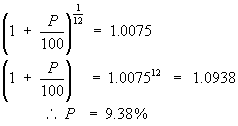If an amount A is invested and the annual interest rate is P%, then the amount in the account after one month is


What is the Annual Equivalent Rate (AER), and how is it calculated? |
The Annual Equivalent Rate (AER) is generally quoted when refering to interest paid on investments. It shows what the notional interest rate would be if the interest was compounded and paid annually instead of monthly (or any other period).
A bit of background revision before we go any further...
If an amount A is invested and the annual interest rate is P%, then the amount in the account after one month is
Suppose £1000 was invested in a savings account which promised an AER of 5.5%, with
interest being paid monthly. Then the amount in the account at the end of one month would be

This means £4.47 interest was paid in the month.
If the interest was taken out each month as "income", the capital invested would remain
£1000, and the interest would be £4.47 each month (assuming no rate change).
So the total interest paid in one year would be
£4.47 × 12 = £53.64
So the interest actually received was equivalent to 5.364%, because the interest was taken out each month. If the interest had been left in, you would earn interest on the interest (i.e. the interest would be compounded) and in that case the rate would be the AER quoted, namely 5.5%, meaning that at the end of the year there would be £1055 in the account.
QUESTION
A savings account promises a gross monthly income of £150 on a capital investment of £20 000. What is the AER?
ANSWER
Let the AER = P%. Then the value of the investment at the end of the months will be

Solving this for P gives:

So the quoted AER would be 9.38%, although the actual interest paid out in a year would be £150×12 = £1800 which is just 9% of the capital £20000.
Note that all the interest here is gross. In practice, tax would be deducted from interest. Also, the calculations above are assuming that a year consists of 12 equal months. In practice, the amounts would vary slightly due to months having different numbers of days.